

Fatigue Pants
Daiki Suzuki
from ENGINEERED GARMENTS
2019.05.01


VOL.10
Find out little-known yet interesting facts about clothing through the words of discerning designers who have been creating
essential masterpieces for BEAMS PLUS collections.
The crucial new philosophy of BEAMS PLUS,
“Updating timeless classics for the future,” cannot be achieved without their wealth of knowledge.
vol.10
Fatigue Pants
Daiki Suzuki
from ENGINEERED GARMENTS

Daiki Suzuki (Designer of ENGINEERED GARMENTS)Suzuki was born in 1962 and is currently based in New York. After working at famous American casual clothing store REDWOOD in Shibuya as a sales person and later manager, he became a buyer of a concept store, NEPENTHES, and then moved to the U.S. in 1989. In 1999, Suzuki launched ENGINEERED GARMENTS as an in-house brand for NEPENTHES New York. Having stuck to now-rarely-seen U.S. manufacturing, he is currently known as a Japanese designer who make more American clothes than any American designers. In 2008, he was selected as the first "Best New Menswear Designer In America" by CFDA and GQ magazine.
I wear fatigue pants
just like a pair of blue jeans.

The design is simpler than
any other military pants,
and that
makes the item even more special.
“Fatigue pants had been used as workwear by the U.S. Army. The design might be already existed before it became a military uniform. Those pants are also known as ‘utility pants’ or ‘OG-107,’ but nobody actually knew the names when I was young and we just called it ‘army pants.’ We would use the name ‘four-pocket pants’ when differentiating it from the ones with two more cargo pockets on the sides.”
“Now the item is widely known as ‘baker’s pants’ in Japan, but the name is not used in the U.S. as far as I know. So, it may be a Japanese-made English word. I think the name was created in the 1990s because it hadn’t been used in the fashion industry before I moved to the U.S. There are several views on what it was named after, with some saying that the item was originally worn by bakers, while others argued that it was because a patch pocket on the pants looked like a slice of bread. No one actually knows the real origin of the name.

The pants were formally called ‘TROUSERS, MEN'S COTTON SATEEN OG-107.’
OG stands for Olive Green and 107 is a color code used by the U.S. Army.




Fatigue pants are typically made with a single fabric with a button fly front, front patch pockets on both sides, a back patch pocket and a back flap pocket. Unlike other types of military pants, all the pockets of fatigue pants are patched on. I think it’s because the durable yet easy-to-make design helped improve productivity. While six-pocket pants were made for field battles, these four-pocket ones were designed to be worn for various activities such as work, training and factory labor. Fatigue pants were, therefore, designed very simple to be supplied to a vast number of soldiers. Another reason of the solid design was just because it was made earlier than other types of pants, I guess.
The item was originally made with cotton herringbone twill fabric, and the material was changed to famous cotton back satin in the mid-1950s. Around the late 1970s, poly-blend fabric was used for the pants. Also, the earliest model featured a separate waistband, while the later models were designed with Hollywood waistbands. There are various other differences in the details and shapes such as adjuster tabs and button materials. The stitches were also changed from durable double stitching to more efficient single stitching in accordance with the times.”


The earliest model was made with herringbone twill fabric, featuring a separate waistband.
Back satin fabric was often used for the later models with Hollywood one-piece waistbands.
It didn’t used to be a
fashionable garment.
American
skateboarders changed my view.
“Because military surplus clothes were often sold cheaply at general stores in the U.S., fatigue pants might become commonly worn by non-military people in the country much earlier than Japan. But I guess it wasn’t considered as a stylish item at all as it was originally made as everyday workwear. We saw American people wearing it in some movies or TV dramas without knowing what it really was, and blindly thought it was cool just because Americans wore it.
Actually, the item began to be accepted as a fashionable item probably in the beginning of 1980s in Japan. I was in my early 20s. Around that time, magazines such as Thrasher featured snaps of American skateboarders in their fully buttoned-up flannel shirts and six-pocket army pants matched with basketball shoes, and such style intrigued me so much.
Although the pants had been sold at bargain prices in some military clothing stores in Ueno before then, it was considered as a tacky item often worn by moneyless young men. The olive green color was called ‘Army Color’ in Japan and elderly people and people in my parents’ generation often regarded it as something worn by a member of Self-Defense Forces or an enthusiastic patriot. At first, I also thought like that and couldn’t buy it. But the way American skateboarders wearing it totally changed my mind.”


“Later, an American casual clothing store in Shibuya, for which I was working as a sales person, started to carry the pants. But our customers seemed to feel awkward about wearing it, as expected. They often asked me if it looked really nice (laughs). Some of them had purchased it after being convinced by our recommendation, and actually fell in love with it. With such a favorable reception, we began to introduce the item more actively to our customers. And, in fact, it did sell well.
But the pants were not as popular as jeans and chinos. Only some young people wore it at that time. I also felt that it might not be okay to wear army pants in my hometown in Aomori, although I thought there was no problem to do so in Tokyo. When my local friend invited me to his wedding party around that time, I bought a tuxedo for myself to match with a proper shirt, tie and a pair of dress shoes. But I felt like something was not right. So, I wore fatigue pants instead of tuxedo trousers. Though the style looked cool for me, I worried if it’s okay to be honest (laughs).”
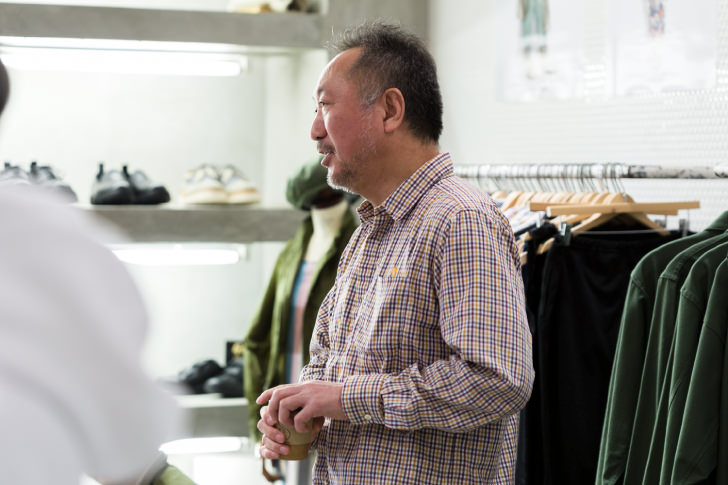
“I’ve been inspired on how to wear fatigue pants by many people, including other stores’ staff such as BEAMS stores’ sales persons and my friend working at THE BACKDROP, along with our customers. It feels so fresh to see people wearing the pants in a way I have never thought of.
The most impressive look with fatigue pants was worn by our female customer who used to work for a designer brand. She looked so sophisticated in her pants matched with a plain button-down shirt and a pair of loafers. She later began her career as a fashion stylist, and her own brand currently receives more and more attention. Oh and I must mention about my senior in business who runs a shop in Kumamoto. He mix-and-matched a pair of oversized military pants with smart garments such as a British-made jacket and waistcoat, a high collar shirt and dress shoes. I love such mixed-up styles, too. To name a celebrity whose way of wearing fatigue pants is unforgettable, John Belushi is the one. After he passed away, a Japanese magazine featured him wearing the pants on its cover. The photo is my favorite because the item perfectly fits his frame and personality.”
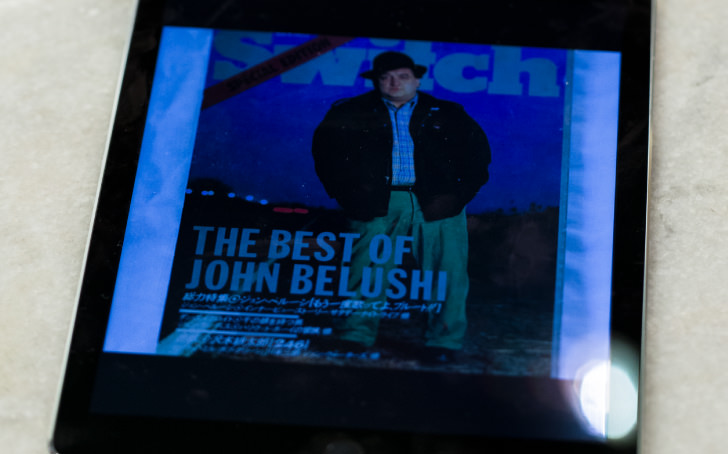
The cover of Switch magazine’s Belushi issue published in August,
1986 from Fusosha, with a photo of the actor, comedian and musician.
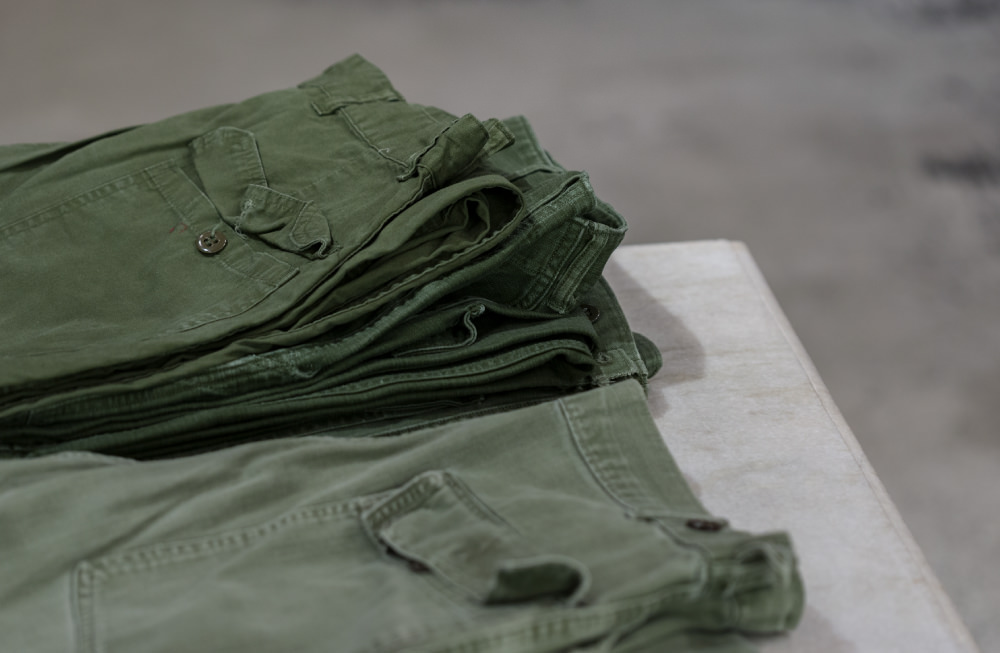
It cannot be more nor less.
I therefore
feel the essence of universality in it.
“Having tried so many different types of military pants designed in the U.S. and other countries, I ended up with the four-pocket fatigue pants, because the minimum structure and design always attract me as I mentioned before. It cannot be more nor less. I therefore feel the essence of universality in it.
The design is probably an already-completed just like five-pocket jeans and chinos, as the modesty and versatility of fatigue pants also have much in common with the two popular garments. How we wear the pants is more like the way we do with jeans, because we usually own more than one pair of jeans as the color and length of each pair are slightly different from others. It’s quite similar to fatigue pants, and that is why I see the item in the same way I do for jeans.”

“Fatigue pants became my everyday staple after the very first encounter. I wear other types of pants only once or twice a year. So, people around me often say that I’m always wearing the same pants (laughs). I actually change my pants every day although each of them looks similar to the others. I don’t know how many pairs I own, but a wall in my house is covered by a shelf filled with olive green pants. Contrarily, I own just a few olive colored top, including a MA-1 jacket. I want more because I love military clothes, but I try not to do so because I may look like a real soldier if my whole look is in olive. The color matches well with almost all colors except the same one, but I mostly mix my pants with white, navy or beige tops.”
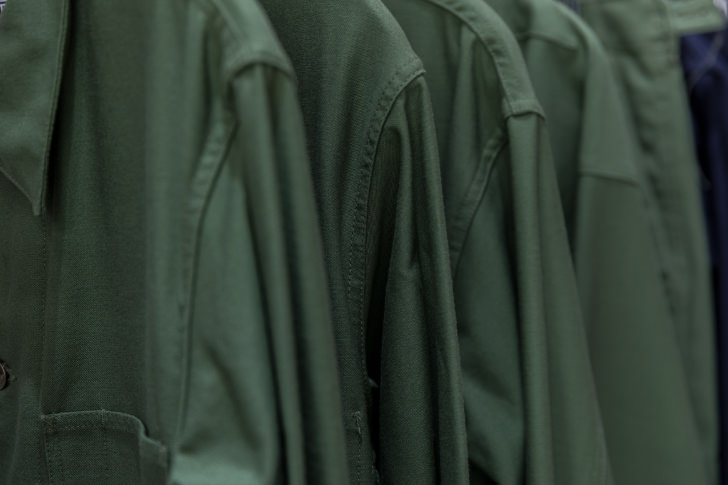
“Though ENGINEERED GARMENTS started as a brand specialized in pants, we didn’t offer fatigue pants at the beginning. Despite my will to make our own model, we didn’t need to do so because people could buy secondhand ones cheaply. Around 2001, we finally launched our first fatigue pants after being frequently asked by our customers whether the vintage pants I personally wore every single day was from our brand. The first model was designed with a loose-fit silhouette just like a vintage pair, but it was actually the time when slim pants with a low waist became popular. So, our high-waisted wide-leg pants didn’t sell well. We then re-launched it around 2003 with a lower waist and slightly tapered leg to fit the mood of the time.
Fatigue pants have been one of the staples of our brand since then. In the past, we had updated the item every season to characterize it by adding some tailoring details, using wool fabric and attaching zipped pockets. A few years ago, however, I realized that fatigue pants look best in its original state and stopped adding any change. After twists and turns, we went back to the basics in the end. Simple is indeed the best. It’s my honest thoughts on the item right now. My such feelings have often changed over time, and it will gradually alter in the future. But I think it’s okay because fashion always comes with constant changes.”

“For our latest collaboration, BEAMS+ (BEAMS PLUS) gave me a theme for our collaboration. It was ‘a formal outfit for Daiki Suzuki to attend the 20th anniversary party of BEAMS+ .’ After telling me the theme, they allowed me to design the garments as I liked. So, I made fatigue pants as a part of the outfit, drawing inspiration from my own experience of attending my friend’s wedding party in a pair of fatigue pants matched with a tuxedo jacket in my 20s, as I told you.
Because since then I’ve often mixed army pants with formal attire for dress-up occasions, the look soon came to my mind. This collaborative outfit is consisted of an elegantly shawl collar jacket with a pair of fatigue pants. Although their initial request was to make an all-black look, I added an olive color option just for my personal satisfaction. The pants are, however, designed with black side stripes just like tuxedo trousers to fit into the atmosphere of the matching jacket. So, each of the items can be matched comfortably with the other as a suit.”
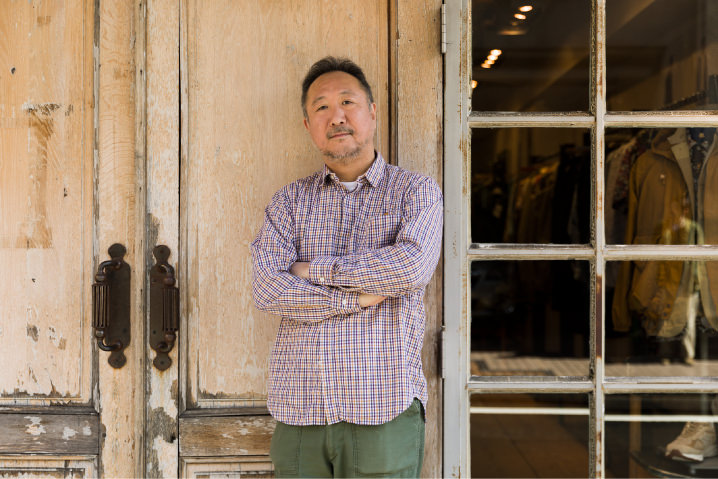
- Edit : Masayuki Ozawa
- Writing : Naoyuki Ikura
- Translation: Aya takatsu
- Photography : Shunsuke Shiga
- Illustration : Naoki Shoji
- Design and Development : maam.inc
(Left) Back Satin Diner Fatigue Pants
Color : BLACK, OLLIVE / Size : XS, S, M, L / Price : ¥33,000+tax(Center) Wing Collar Shirt
Color : WHITE / Size : XS, S, M, L / Price : ¥26,000+tax(Right) Single Diner Hi Count Twill Jacket
Color : BLACK / Size : XS, S, M, L / Price : 46,000+tax

The products shown in this article are
available at BEAMS PLUS stores.
BEAMS MEN SHIBUYA / BEAMS ROPPONGI HILLS /
BEAMS TSUJIDO / BEAMS KOBE / BEAMS HIROSHIMA
vol.15
American Suit
Hisao Saito
from TUBEvol.14
BACKPACK
Takao Fujimoto
from STANDARD SUPPLYvol.13
5 Pocket Denim Pants
Kenichi & Koji Shiotani
from WAREHOUSEvol.12
Luggage Wear
Setsumasa Kobayashi
from .....RESEARCHvol.11
Leather Wallet
Daisuke Motoike
from MOTOvol.10
Fatigue Pants
Daiki Suzuki
from ENGINEERED GARMENTSvol.09
Tie
Kenichi Kusano
from KENNETH FIELDvol.08
Tote Bag
Shinshu Kosuzume
from BRIEFINGvol.07
Coverall Jacket
Takeshi Ohfuchi
from Post O'Allsvol.06
Balmacaan Coat
Shinsuke Kojima
from KAPTAIN SUNSHINEvol.05
Western Shirt
Yutaka Goto
from REMI RELIEFvol.04
M-51
Kimitoshi Chida
from sage de cretvol.03
Sweat
Satoshi Suzuki
from LOOPWHEELERvol.02
Open Collar Shirt
Hirofumi Yamashita
from MOJITOvol.01
Blazer
Jack Carlson
from ROWING BLAZERS





































